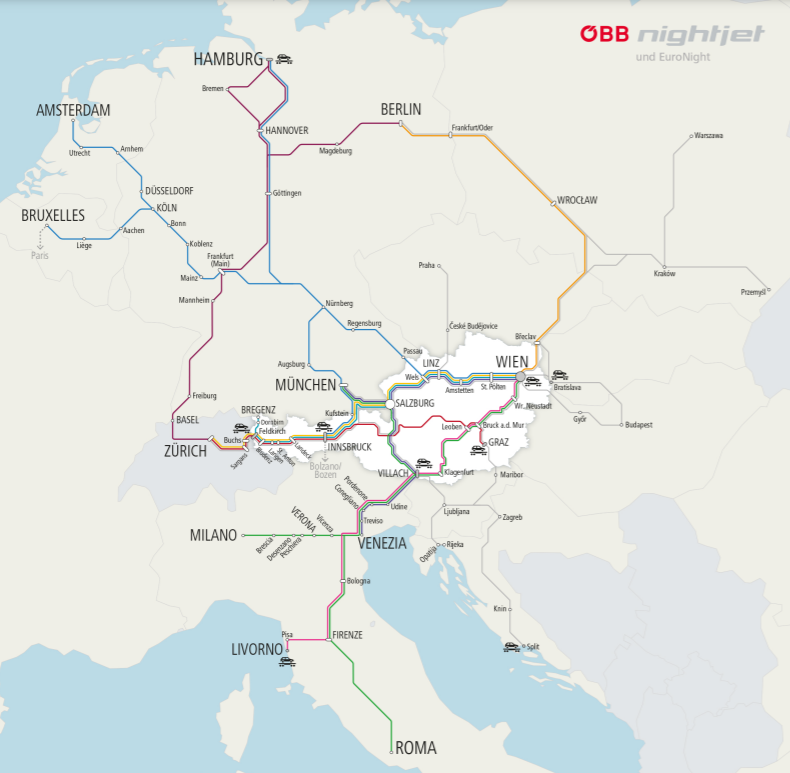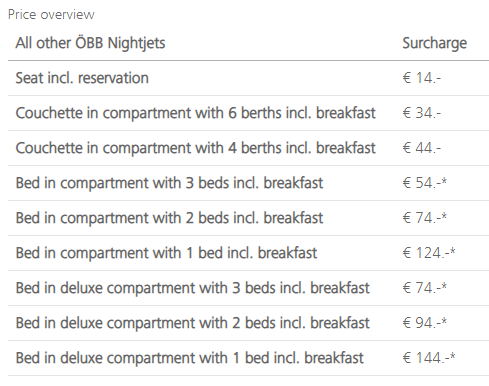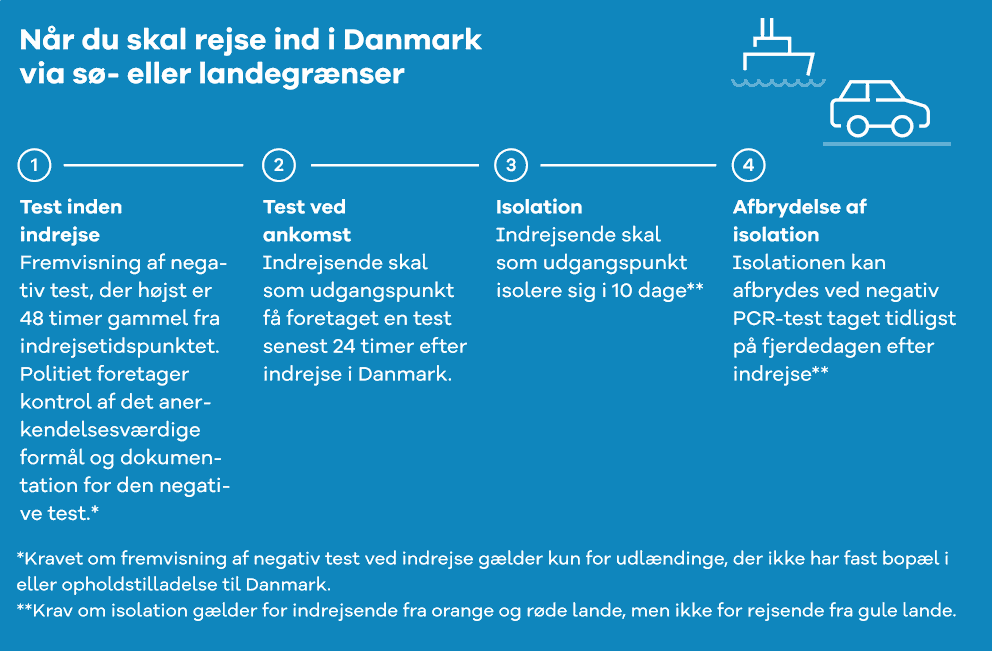Taking the train 🚅 with Interrail instead of burning jet fuel when traveling within Europe from Denmark
Introduction to the Interrail Pass, and how to plan a trip within Europe from Denmark using a more sustainable means of transport than flying.

Motivation
I got convinced to travel by train instead of by plane when I realized that my annual overall transport footprint (round-trips in Europe + 1 long-haul flight for instance to Eastern Asia or the USA) has a carbon footprint of 1.5t CO2,eq, i.e. as high as 1.5 times my entire annual heat consumption. I've decided to now travel by train "whenever I can", which I translate for myself as all short (~500-1000) to medium (1500-3000) distance trips (where the train is a clear greener alternative in Europe); when I can travel independently without bothering a group, and when I don't have to travel for an urgent matter.
I was introduced by a couple of friends to Interrail, and below is a summary of what I learned about it.
The article focuses on a trip from Denmark to France through Germany, but I'm sure it is also useful as base information for all 30 other countries covered by the pass. If you have any question or comment, do not hesitate to write to me :)
CO2 emissions example
Let's take a round-trip from Copenhagen to Paris
Emission factors
The following factors were collected for a car (optimistic new vehicle rented) and trains along the way.
| Transport mode | Source | CO2 intensity (gCO2e/pers-km) |
|---|---|---|
| Car: average new passenger car in the EU | EU (2019, [1]) | 122.3 |
| Train (France): TGV | SNCF (2020, [2]) | 1.9 |
| Train (France): TER | SNCF (2020, [2:1]) | 24.81 |
| Train (Germany): ICE, IC, EC | DB (2020, [3] | << 1 |
| Train (Denmark): InterCity | DSB (2020, [4]) | 72 |
For air transport, the ICAO Carbon Calculator was used directly on this specific trip, but the intensity can be calculated back to 120 gCO2/pers-km.
Distances
| Transport mode | Source | One-way distance (km) |
|---|---|---|
| Car | Google Maps | 1218 |
| Train | Google Maps | 490 (DSB) + 630 (DB) + 520 (FR) = 1640 |
| Plane | ICAO | 1004 |
Comparison

Notes:
- 3 round-trips by plane emit as much as 10 by train
- 97% of the train footprint is due to the InterCity in Denmark. The Danish system is one of the least electrified in Europe and I did experience that the transport is actually ensured by a Diesel train on that segment
- The numbers depend on the assumptions used. The German train segment is considered to be CO2-emissions free but renewable energies have a non-zero carbon footprint.
Interrail
What is it?
Interrail (for EU residents i.e. EU and non-EU citizens with legal residence in an EU country) and Eurail (for non-EU residents) are rail passes which permit flexible and unlimited travel over a period from 15 days to 3 months. They give access to 40 railways companies in 33 countries, as well as discounts on some ferry (e.g. Fjord Line in Denmark) and public transport company (e.g. S-Bahn in Germany). The two passes are managed and marketed by the Eurail Group G.I.E, based in Utrecht in the Netherlands.
They are declined in 2 versions:
- The Global Pass, which allows 1 inbound and 1 outbound trip to and from your country of residence, and unlimited travel in the others
- The Country Pass, which allows unlimited travel in the country of your choice
The list of countries where the Interrail Pass is valid, is shown in the image below (source: Wikipedia). You can also look at the detailed PDF map from Interrail.

Is it worth it financially?
Compared to taking the plane, it's a tough game. Some flights are insanely cheap (Ryanair or Easyjet), and trains in general rely on costly physical infrastructure and maintenance and therefore rather expensive. So in general, if you target a single country (for holidays or for a weekend), it will most likely be at best on par, if not more expensive to take the train. But it may be way cheaper if you want to travel around Europe through multiple countries.
Compared to just booking normally the tickets that you need, it depends, but it's usually worth it when you travel over a rather long distance and for more than just a round-trip. Once paid, the pass allows you to travel aaaalmost for free, BUT, there are some countries or some types of train which require (paid) reservations. An example is the TGV in France (10, 20 or 30€), or Night trains in Germany (from 14€ to 44€ depending on the comfort). See also further below.
To begin with, check the normal price for instance on https://www.thetrainline.com and compare with the Interrail Global Pass prices. And add some multiple of 10 depending on how much you intend to travel via those paid for routes.
Here's the price list for 1 Adult in 2nd Class:
| Type | Price at DSB[5] (in €[6]) | Price on Interrail.eu |
|---|---|---|
| 4 travel days within 1 month | 1870kr. (251€) | 214£ or 246€ |
| 5 travel days within 1 month | 2144kr. (288€) | 245£ or 282€ |
| 7 travel days within 1 month | 2546kr. (341€) | 291£ or 335€ |
| 10 travel days within 2 months | 3048kr. (409€) | 349£ or 401€ |
| 15 travel days within 2 months | 3747kr. (503€) | 429£ or 493€ |
| 15 days unlimited | 3367kr. (452€) | 385£ or 443€ |
| 22 days unlimited | 3937kr. (528€) | 451£ or 518€ |
| 1 month unlimited | 5092kr. (683€) | 583£ or 670€ |
| 2 months unlimited | 5556kr. (745€) | 636£ or 731€ |
| 3 months unlimited | 6856kr. (920€) | 785£ or 902€ |
The prices in DKK (at the Train Station), EUR or GBP (through Interrail) are within 2.5% of each other. At time of writing, they were more expensive in DKK.
The good thing is, that there are also discounts depending on your age:
| Age group | Age range | Discount |
|---|---|---|
| Children | 0-11 | Free |
| Youth | 12-27 | Up to -25% |
| Adult | 28-59 | - |
| Senior | 60+ | -10% |
Where to buy one?
You can get either:
- a Mobile Pass via the Interrail App (new, and recommended !)
- a Paper Pass
- sent by post if you start your travel in more than 10 weekdays:
- directly from the counter at DSB Salg & Service in København H, Aarhus H or Odense Station. If you plan to start your travel within 10 week days, you need to get to go to one of those 3 train stations if you want a paper pass.
Checking the route, before and during the trip
Interrail offers an Online Timetable and the mobile app "Rail Planner" to help plan trips. It's a good place to start.

Online train aggregators like The Train Line (https://www.thetrainline.com) can also be useful to check which is the best route for you, if you're used to using these apps anyway.
The website of the Deutsche Bahn (https://www.bahn.de/) is a good recommendation as well. Their DB Navigator mobile app is really good as it also enables to check live during your trip for potential delays, next stops, connections, platform numbers, etc for German trains.
Reservations
Reservation requirements
Almost most routes covered by Interrail don't need reservations, some countries or types of train require reservation. Typically in France, Italy, Green and Spain, many trains require reservation.
Highlight per country:
- France: TER and most InterCité don't require reservation, but TGVs and the rest do.
- Germany: mostly no reservation requirement. However, some international high-speed connections (e.g. Frankfurt-Paris) or the ÖBB Nightjet (Night trains)
Interrail's Online Timetable and Rail Planner apps both show which parts of your planned journey require reservation.
Reserving via the Interrail Booking System
Interrail has a self-service booking page where you can book tickets for a 2€/pers./trip fee, up to 3 hours (e-tickets) or 6 days (paper tickets) before depaerture. The service is not available for Spain, the UK, Portugal, Bulgaria, Serbia, Greece and the Baltic countries.
Given the time and country limitation, the fee, the errors encountered, and the sometime non-optimal journey split (leading to higher costs) it sometimes proposes, I suggest to proceed with direct booking for the different countries.
Direct booking for Denmark: DSB
Traveling is free. Cross-border reservations cannot be made via the DSB app but via the DSB website (https://travel.b-europe.com/dsb-rail/dk/booking#TravelWish), or at the train stations either when buying the pass, or using the red machines.
During the Covid-19 pandemy, seat reservations are mandatory. This can be done via a special page on the DSB website for cross-border tickets: https://travel.b-europe.com/dsb-rail/dk/reservation-only#TravelWish
Direct booking for Germany: Deutsche Bahn (and ÖBB)
The best is to contact the Deutsche Bahn by telephone after having checked the itinerary on their website. Contact info available on bahn.com.
Turns out the option for Denmark has low waiting time and very nice people on the line:
Information in Danish:
+49 30 473 91883
(The standard fees for calls to the German landline network apply.)
Mon-Fri: 09:30 to 21:00; Sat-Sun: 10:00 to 14:00 (only in English or German)
Traveling is free, except for night trains. Seat reservation is not free.
- ICE: Pladsbillet 4EUR (ICE)
- ÖBB NightJet: see below
Tickets are paper based, so they must be either sent by post to your home address, or (best option) be made available for print at any of the red machines in German train stations. You pay online with your credit card and then their backoffice confirms a bit later with an email containing the pick up code and instructions in English.
ÖBB NightJet
The Austrian railways manages important night train lines from Rome to Hamburg, as seen in the map below. They are pretty cool as they've ordered a fleet of new trains with nice interior to take departure in 2022.

With an interrail pass, there is surcharge depending on the type of seat/couchette.

As a comparison, a normal ticket a week from time of writing, for a couchette in a 4-berth compartment was 239,80€, vs a 44€ surcharge if you have an interrail. So rather worth it.
It is recommended to purchase the surcharge in advance. If you purchase it on the train, an additional service surcharge applies.
Customer service:
+43 (0)5 1717
From 6 a.m. to 9 p.m.
Really nice people on the phone
Direct booking France: SNCF
TERs and most InterCité are free, but TGVs for instance require paid reservations: 12, 24 or 36€ depending on the distance and the time of day.
Unfortunately, it is not possible to select "Interrail" as a Discount Card in the search function of the official oui.sncf website (it used to work using the Swiss version but not anymore) nor on thetrainline.com for instance. So, the only possibilities are:
- Contact SNCF on the phone: +33 1 84 94 3635. NOTE (!): you can only pay with a French credit card. I was told on the phone that they had too many issues with foreign credit cards and have therefore removed this possibility.
- Go to a French train station
- Use the Interrail Self-Service Booking service and accept to pay a 2€ fee
Note: SNCF on board agents are the most reckless of all I've experienced. They won't let go if you've forgotten to write the travel date on your pass, and that's a 50€ fee if you pay directly.
Covid-19 Requirements
General rules
It's now a given that people should wear a mask when in public transport.
In Denmark
According to https://www.dsb.dk/coronavirus/, there is a requirement for
- Reserving a seat (Pladsbillet), which is free during the pandemic
- Wearing a mask (mundbind) or a screen (visir)
Destination and transit countries
The EU has a nice page (and a mobile app) where you can get up-to-date info about your entire journey: https://reopen.europa.eu/da/from-to/DNK/FRA/DEU
For instance, at time of writing:
- To enter France: negative test taken max 72 hrs before departure
- Germany: no requirement when transiting
For more info:
- check the embassy's websites:
- France: https://frankrig.um.dk/da/rejse-og-ophold/nycoronavirus-covid19/
- Germany https://tyskland.um.dk/da/rejse-og-ophold/nycoronavirus-covid19-tyskland/. At time of writing there is a curfew between 22:00 and 5:00 (OK to walk your dog)
- and the railway companies' websites:
- Germany: https://www.bahn.com/en/view/home/help/corona.shtml. At time of writing, it says that there is reduced availability for seat reservation but there's no requirement to reserve a seat. As explained in https://www.bahn.com/en/view/home/help/corona-seat-reservation.shtml, it's been their decision to still allow people to hop on a train at the last minute.
Way home
Check the official website for the latest requirements when entering back Denmark : https://coronasmitte.dk/raad-og-regler/emner/rejser-til-eller-via-danmark/lovkrav-ved-indrejse
At time of writing, the following rules apply when entering the country from the land or the sea:
- Testing is not necessary for Danish citizens and residents in Denmark. For the rest, rules depend on the country of origin.
- Self-isolation is required for 10 days, unless a negative test taken on the 4th day after arrival is negative. This requirement is not necessary for people that are fully vaccinated.

- Test taken max 48 hrs before entry
- Test max 24 hrs after entry
If you're coming back from France, the following website explains how and where to take a test: https://www.gouvernement.fr/info-coronavirus/tests-et-depistage
Quick shortcut list
- DB Phone Number: +493047391883
- ÖBB Phone Number: +4351717
- SNCF Phone Number: +33184943635
- DSB Seat Reservation: https://travel.b-europe.com/dsb-rail/dk/reservation-only#TravelWish
- ReOpen EU: https://reopen.europa.eu/da/from-to/DNK/FRA/DEU
European Environment Agency (2021), https://www.eea.europa.eu/data-and-maps/indicators/average-co2-emissions-from-motor-vehicles-1/assessment ↩︎
SNCF (2020), Calcul de la quantité de CO2e émise lors d’un trajet, https://www.oui.sncf/aide/calcul-des-emissions-de-co2-sur-votre-trajet-en-train ↩︎ ↩︎
DB's long distance services are particularly green: since the beginning of 2018 all customers travel on ICE, IC and EC trains within germany by 100 percent renewable power. https://gruen.deutschebahn.com/en/measures/environmental-mobility-check ↩︎
DSB (2019), Tal om miljøet, https://www.dsb.dk/om-dsb/baeredygtighed/miljo/fakta-om-miljoet/ ↩︎
https://www.dsb.dk/find-produkter-og-services/interrail/produkter/ ↩︎
1 EUR = 7.45 DKK ↩︎
